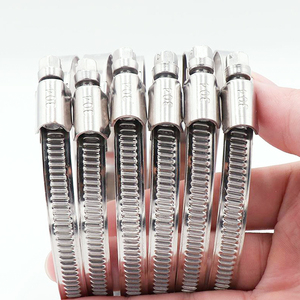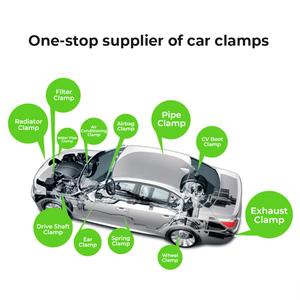
All categories
Featured selections
Trade Assurance
Buyer Central
Help Center
Get the app
Become a supplier

(47516 products available)












































Pump clamps have a wide variety of applications in the agricultural sector, ranging from livestock watering to irrigation and chemical spray.
The following are the types of pump clamps based on their specific uses:
Livestock Watering Pumps
In pump clamps employed for livestock-related watering, the most widely used materials are those that will not affect the ecosystem of the water. This ensures that all plants and animals remain safe while water is delivered to places where it is needed by troughs and ditches. These clamps are strong enough to carry the heavy task but light enough not to damage the hose.
Irrigation Pumps
Irrigation pump clamping devices in agricultural practices use similar principles. Large quantities of water for crops are distributed from one area to another with the help of irrigation pumps to ensure efficient agricultural production. Irrigation pump clamps are suitable for high-pressure applications due to their durable construction. They are manufactured to support the ancillaries of large pumps to aid in the irrigation of large agricultural lands.
Chemical Spraying Pumps
Chemicals like fertilizers and pesticides must sometimes be transported through pumps. Because of this, there are clamps made of corrosion-resistant materials for such usage. These clamps may be used on irrigation or water pumps, but chemical-resistant materials must be added to mitigate the effects of aggressive chemical substances.
Submersible Pumps
Farmers use submersible pumps to extract water from deep wells and underground sources. These pumps usually require hose clamps that can bear the high-stress levels associated with underground extraction. These clamps are thus like those used in irrigation or livestock watering because they are constructed from materials that can withstand great pressure.
Pump clamp is used in almost all farming processes. They are widely used in hoses, pumps, and piping systems to ensure proper installation and functionality.
The following are the uses of pump clamps in agriculture:
Hose and Pump Connections
Livestock and irrigation pumps, chemical spray pumps, and submersible pumps are all used by farmers. These pumps need clamps to hold hoses secure so they can transmit water, feed, or chemicals. Metal clamps are often used with irrigation hoses because they must be durable, while plastic clamps may work for lighter tasks such as transferring water to animals.
Piping Systems
Pump clamps are widely used to support and secure pipes in irrigation systems. These clamps reduce the movement of pipes, which helps avoid leaks and wastage. Farmers also use clamps to mount pipes and transfer liquid fertilizers, pesticides, and water to designated areas in the field.
Vibration Reduction
Pumps can vibrate during operation, making them difficult to operate and damaging nearby equipment. Clamp brackets are widely used to dampen this vibration, thus protecting the pumps and increasing the lifespan of other nearby equipment.
Equipment Mounting
Pump clamps are used to mount pumps on farming equipment like sprayers and irrigators. Farmers can use clamps to fix the pumps properly, thus making the pump work better and more efficiently.
Maintenance and Repairs
Clamp brackets need to hold pipes, pumps, and hoses in place during the maintenance of irrigation or livestock watering systems. This is because, without proper maintenance, the farming system could break down. Hence, farmers should have pump clamps ready for any maintenance and repairs.
Pump clamps are available in various sizes and specifications to accommodate different pump and hose diameters. Common sizes range from small residential systems (1 inch) to large industrial or agricultural setups (over 6 inches).
Corrosion Resistance
Pump clamps are constantly wet; hence, these clamps are made of rust-resistant materials. Stainless steel or galvanized steel is the best pump clamp material for long-lasting machines.
Adjustability and Tightening Mechanisms
Many clamps are adjustable, meaning they can be tightened or loosened easily. This might be necessary when maintenance is being done on the pump.
Vibration Dampening Features
Some advanced clamps even have rubber inserts or cushioning mechanisms that help reduce vibrations from the pump. This is to protect the tools and the external components of the pump.
Regular Inspections
Farmers should always conduct regular inspections of pump clamps. This is important because when a clamp is loose, leaks are possible, which may damage either the pump or the surrounding infrastructure.
Corrosion and Wear
Inspect the clamps for any signs of rust or deterioration if pumps are used for irrigation, chemical spraying, or livestock watering and are likely to be in corrosive environments. Old clamps should be replaced to avoid future problems.
Tightening
Adjustable clamps need to be properly tight to hold the hoses in place. Similarly, they should not be overly tightened, as this may damage the hose. Maintenance of pump clamps mostly requires adjustable pumps to be checked for tightness.
Vibration
Farmers should also check pump clamps for signs of vibrations. This is because excessive vibration could cause pump damage and hinder the functioning of nearby tools.
Material
Pump clamps are made of several materials, including metal (stainless and galvanized steel) and plastic. Each one has its unique benefits. For example, stainless steel pump clamps are ideal for outdoor and farming use because they are weather and corrosion resistant. Plastic pump clamps are good for transferring water to animals because they are lightweight and will not rust.
Size
Pump clamps come in various sizes. Select the right size pump clamp for the task at hand. A clamp that's too small will not hold anything securely, while one that's too big will slide around and not offer the support needed.
Adjustability
If the clamp will be used in various applications, consider getting an adjustable clamp. These adjustable clamps allow the user to resize them to fit different diameters.
Tightening Mechanism
Adjustable pump clamps have different tightening mechanisms, such as screw-to-tighten or quick-release designs. Quick-release mechanisms are easy to use when regular adjustments are needed. In contrast, screw-to-tighten mechanisms offer more stability and are best for permanent or long-term setups.
Vibration Dampening
Some clamp brackets have rubber inserts or cushioning that help reduce vibrations from the pump. This is beneficial as it protects the clamp and the components attached to it.
Compatibility
Ensure the clamp is compatible with the specific hose and pump types on the farm. Pump and hose manufacturers often recommend specific clamp types to be used.
A1: In farming, pump clamps are used to secure hoses and pipes on water and irrigation pumps, chemical spray pumps, and submersible pumps to facilitate proper water transfer, irrigation, and crop spraying.
A2: Pump clamps are made from stainless, galvanized, and mild steel, plastic, and rubber. Each material has its advantages. For instance, stainless and galvanized steel are rust and weather-resistant, while plastic is lightweight and will not corrode.
A3: Regularly check pump clamps for signs of rust or deterioration, inspect them for looseness and re-tighten where necessary, and examine them for signs of excess vibrations.
A4: Water pumps, irrigation pumps, livestock water pumps, chemical sprayers, and submersible pumps, which are manufactured for various pumping applications, need pump clamps.
A5: Using adjustable pump clamps is beneficial because they can be resized to fit different applications.